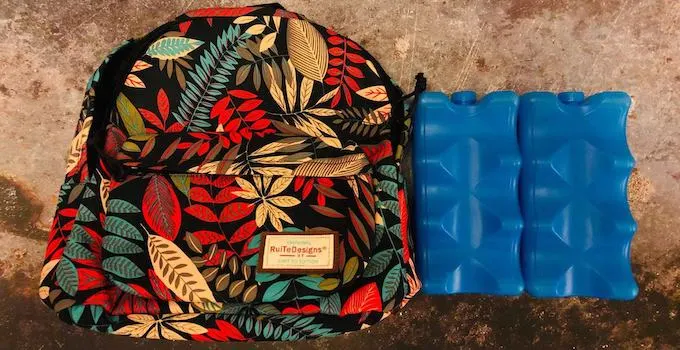May I carry ice packs in my hand luggage?
As a rule, freezer packs may only be carried in hand luggage if they are used to cool medications requiring refrigeration (exception). For these medications, you also need a medical certificate, which certifies the necessity of the medication and the appropriate cooling.
You may NOT use ice packs to cool food or other goods in hand luggage due to the rule for liquids in hand luggage.
Carry ice packs for the transport of medicine
If you are indeed carrying medication that needs to be refrigerated in your hand luggage, you may use the freezer packs for cooling. This is because there is an exception rule here and the rule for liquids in hand luggage does not apply here.
However, it is essential that you consult the airline and have this confirmed in writing.
It is best to print out this written confirmation immediately and take it with you in your hand luggage so that you have something to show to the personnel at the security checkpoint if problems should arise.
In addition to this confirmation, you must also have a doctor’s certificate (in English!) for the medicines requiring refrigeration.
That’s what Ryanair and Co. say about freezer packs in hand luggage
I have just been in contact with Ryanair and I was assured that they allow ice packs for the transport of medicines, but only if the transport is announced in advance via the Live Chat or the Ryanair Help Centre.
Ryanair wants to know exactly what and how much will be transported.
EasyJet only said in the live chat that the liquid rule in hand luggage should also be observed for the freezer packs. But we already knew that.
The question of whether the ice packs may be used to cool medicines (this exception normally applies, see introduction) could unfortunately not be answered by the employee in the live chat.
On its Facebook page Lufthansa clearly confirmed to a passenger that ice packs may be used to cool medicines requiring refrigeration.
What about cooling gel packs in hand luggage?
In addition to ice packs which come in plastic containers (usually blue as in the picture) and are normally filled with a cooling liquid (salt water) and additives, there are also so-called gel packs. The gel packs are usually filled with a cooling gel.
Since cooling gel is also a liquid, the same applies for cooling gel packs as for ice packs: Generally these are forbidden in hand luggage due to the rule for liquids, but if used to cooling medicine, they are allowed. In this case, the Same rules apply as for ice packs.
Proof of the fact that cooling gel packs are allowed in hand luggage when serving the purpose of cooling medicines can also be found on the GOV Site of the UK
Very small ice packs & gel packs should be allowed, shouldn’t they?
We have seen that cooling packs & cooling pads in carry-on baggage are generally prohibited as they violate the rule for liquids in carry-on baggage. But what exactly is being violated?
The main problem is that freezer packs & gel packs almost always have too high a capacity per container. According to the liquid rule, only containers with a maximum of 100 ml each are permitted.
Another problem is that liquids in hand luggage always have to be transported in liquids bags.
If you now want to transport very small ice packs or gel packs (with max. 100 ml per container), the transport would have to take place in this liquids bag. But you probably want to use it to cool your goods on the way.
So to put it plain and simple: You cannot carry the cooling packs & gel packs in your hand luggage, even if they have a capacity of less than 100 ml, unless you simply want to carry these mini coolants without cooling anything on the way.
Because in that case you could put these mini packs in the bag for liquids and you should get away with it, if you can really fit them in there!
What are the alternatives to ice packs & gel packs?
You should use dry ice to cool food during your flight. Dry ice is allowed by most airlines in limited quantities, but transport must usually be notified in advance to the airline. This is especially the case if the transport is to take place in checked baggage.
As an alternative to cooling medicines, especially insulin, there is also a special travel bag from the company FRIO that serves this purpose. The special feature of this bag is the fact that it works without coolant. This is particularly practical for air travel, as carrying coolants often leads to problems.
The FRÍO cooler bag is cooled by evaporation. To cool the bag, you only need to immerse the inside pocket of the product in water for a short time.
Short instructions for use:
- Shake the crystals in the compartments of the inner pocket.
- Then dip the inside pocket completely under water (depending on the size of the Frio product, please refer to the operating instructions for the duration).
- The crystals now become a kind of gel, which should not be too rigid, but still flexible.
- Then take the inside pocket out of the water and leave it for about 10 minutes.
- Now you can put the insulin, which you take out of the refrigerator, into the inside pocket.
- Finally, stow the inside pocket in the outside pocket.
Then you can cool your insulin for at least 45 hours – at a temperature between 18 and 26 °C that is optimal for insulin .
Watch your step: Take particular care to ensure that the bag is always well ventilated, as the air supply is crucial to the functioning of the bag.

Hey guys! It’s me, Marcel. I am the proud owner of carry-on-baggage.com. I am dealing with hand luggage related issues on a daily basis and I own several websites in this niche. Travelling is one of my biggest passions in life and I, therefore, happen to know a thing or two about hand luggage. I hope you all have a safe trip! Take care and thanks for the support. I really appreciate it.
